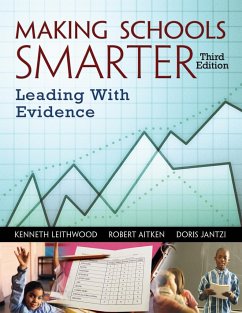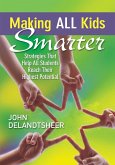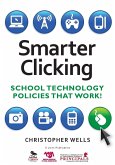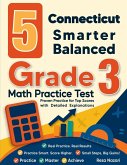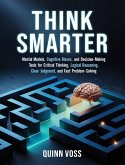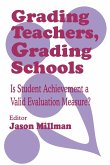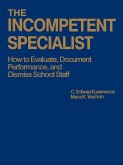- Broschiertes Buch
- Merkliste
- Auf die Merkliste
- Bewerten Bewerten
- Teilen
- Produkt teilen
- Produkterinnerung
- Produkterinnerung
Achieve a workable model for effectively reshaping today's school districts for positive outcomes by addressing three of the most central challenges in district and school leadership.
Andere Kunden interessierten sich auch für
![Making ALL Kids Smarter Making ALL Kids Smarter]() John DeLandtsheerMaking ALL Kids Smarter29,99 €
John DeLandtsheerMaking ALL Kids Smarter29,99 €![Smarter Clicking Smarter Clicking]() Christopher WellsSmarter Clicking29,99 €
Christopher WellsSmarter Clicking29,99 €![5 Connecticut Smarter Balanced Grade 3 Math Practice Tests 5 Connecticut Smarter Balanced Grade 3 Math Practice Tests]() Nazari5 Connecticut Smarter Balanced Grade 3 Math Practice Tests16,99 €
Nazari5 Connecticut Smarter Balanced Grade 3 Math Practice Tests16,99 €![Think Smarter Think Smarter]() Quinn VossThink Smarter28,99 €
Quinn VossThink Smarter28,99 €![Grading Teachers, Grading Schools Grading Teachers, Grading Schools]() Jason Millman (ed.)Grading Teachers, Grading Schools39,99 €
Jason Millman (ed.)Grading Teachers, Grading Schools39,99 €![The Incompetent Specialist The Incompetent Specialist]() C. Edward LawrenceThe Incompetent Specialist37,99 €
C. Edward LawrenceThe Incompetent Specialist37,99 €![Designing Professional Portfolios for Change Designing Professional Portfolios for Change]() Kay BurkeDesigning Professional Portfolios for Change35,99 €
Kay BurkeDesigning Professional Portfolios for Change35,99 €-
-
-
Achieve a workable model for effectively reshaping today's school districts for positive outcomes by addressing three of the most central challenges in district and school leadership.
Produktdetails
- Produktdetails
- Verlag: Corwin
- 3. Auflage
- Seitenzahl: 218
- Erscheinungstermin: 6. Januar 2006
- Englisch
- Abmessung: 280mm x 216mm x 13mm
- Gewicht: 562g
- ISBN-13: 9781412917636
- ISBN-10: 1412917638
- Artikelnr.: 22034704
- Herstellerkennzeichnung
- Libri GmbH
- Europaallee 1
- 36244 Bad Hersfeld
- gpsr@libri.de
- Verlag: Corwin
- 3. Auflage
- Seitenzahl: 218
- Erscheinungstermin: 6. Januar 2006
- Englisch
- Abmessung: 280mm x 216mm x 13mm
- Gewicht: 562g
- ISBN-13: 9781412917636
- ISBN-10: 1412917638
- Artikelnr.: 22034704
- Herstellerkennzeichnung
- Libri GmbH
- Europaallee 1
- 36244 Bad Hersfeld
- gpsr@libri.de
Dr. Leithwood is Emeritus Professor at OISE/University of Toronto. His research and writing is about school leadership, educational policy and organizational change. He has published extensively on these topics. For example, he is the senior editor of both the first and second International Handbooks on Educational Leadership and Administration (Kluwer Publishers, 1996, 2003). His most recent books include How School Leaders Contribute to Student Success (2017, Springer), Linking Leadership to Student Learning (2012, Jossey Bass), Leading School Turnaround (2010, Jossey Bass), Distributed leadership: The state of the evidence (2009, Routledge), Leading with Teachers' Emotions in Mind (2008, Corwin), Making Schools Smarter (Corwin, 3rd edition, 2006) and Teaching for Deep Understanding (Corwin, 2006). Among his awards, Professor Leithwood is the inaugural recipient of the University of Toronto's Impact on Public Policy award, AERA (Division A) 2011 Outstanding Leadership Researcher Award, the 2012 Roald F. Campbell Lifetime Achievement Award from the University Council for Educational Administration and the Ontario Principal Councils' Outstanding Contributions to Education Award for 2016. He is a Fellow of the Royal Society of Canada. With colleagues, he has completed one of the largest studies of its kind about how state, district and school-level leadership influences student learning.
Preface
Acknowledgments
About the Authors
1. Introduction
Part I. Basic Assumptions About Schools and Districts
2. Clarifying Assumptions: Three Perspectives
3. What Is a Professional Learning Community?
Part II. Educational Inputs and Outcomes
4. What Are Schools Given to Work With?
5. What Ought to Be Accomplished?
Part III. Critical Processes and Conditions: A Systems Orientation to the
Core Technology of Schooling
6. Leadership and Management
7. Mission and Goals, Culture and Community
8. Planning and Instructional Services
9. Structure and Organization, and Data-Driven Decision Making
10. Policies and Procedures, and Community Partnerships
Part IV. Gathering and Using School and District Monitoring Information
11. Collecting, Analyzing, and Interpreting Monitoring Information
12. Using School and District Monitoring Information
Appendix A: The School Surveys
Appendix B: The District Surveys
References
Index
Acknowledgments
About the Authors
1. Introduction
Part I. Basic Assumptions About Schools and Districts
2. Clarifying Assumptions: Three Perspectives
3. What Is a Professional Learning Community?
Part II. Educational Inputs and Outcomes
4. What Are Schools Given to Work With?
5. What Ought to Be Accomplished?
Part III. Critical Processes and Conditions: A Systems Orientation to the
Core Technology of Schooling
6. Leadership and Management
7. Mission and Goals, Culture and Community
8. Planning and Instructional Services
9. Structure and Organization, and Data-Driven Decision Making
10. Policies and Procedures, and Community Partnerships
Part IV. Gathering and Using School and District Monitoring Information
11. Collecting, Analyzing, and Interpreting Monitoring Information
12. Using School and District Monitoring Information
Appendix A: The School Surveys
Appendix B: The District Surveys
References
Index
Preface
Acknowledgments
About the Authors
1. Introduction
Part I. Basic Assumptions About Schools and Districts
2. Clarifying Assumptions: Three Perspectives
3. What Is a Professional Learning Community?
Part II. Educational Inputs and Outcomes
4. What Are Schools Given to Work With?
5. What Ought to Be Accomplished?
Part III. Critical Processes and Conditions: A Systems Orientation to the
Core Technology of Schooling
6. Leadership and Management
7. Mission and Goals, Culture and Community
8. Planning and Instructional Services
9. Structure and Organization, and Data-Driven Decision Making
10. Policies and Procedures, and Community Partnerships
Part IV. Gathering and Using School and District Monitoring Information
11. Collecting, Analyzing, and Interpreting Monitoring Information
12. Using School and District Monitoring Information
Appendix A: The School Surveys
Appendix B: The District Surveys
References
Index
Acknowledgments
About the Authors
1. Introduction
Part I. Basic Assumptions About Schools and Districts
2. Clarifying Assumptions: Three Perspectives
3. What Is a Professional Learning Community?
Part II. Educational Inputs and Outcomes
4. What Are Schools Given to Work With?
5. What Ought to Be Accomplished?
Part III. Critical Processes and Conditions: A Systems Orientation to the
Core Technology of Schooling
6. Leadership and Management
7. Mission and Goals, Culture and Community
8. Planning and Instructional Services
9. Structure and Organization, and Data-Driven Decision Making
10. Policies and Procedures, and Community Partnerships
Part IV. Gathering and Using School and District Monitoring Information
11. Collecting, Analyzing, and Interpreting Monitoring Information
12. Using School and District Monitoring Information
Appendix A: The School Surveys
Appendix B: The District Surveys
References
Index

